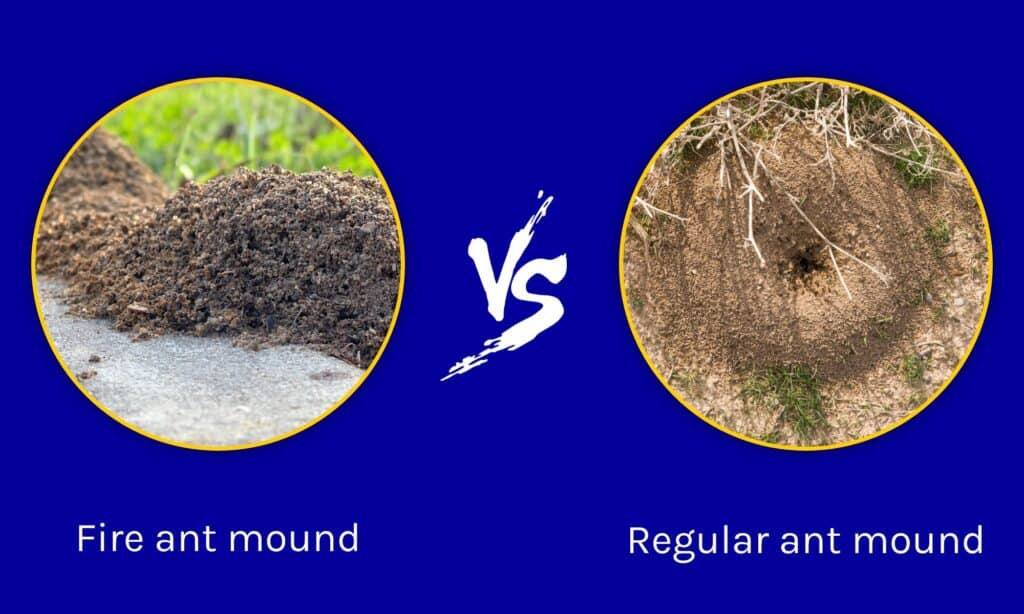What’s the most obvious way to verify that there’s an ant colony in your vicinity? Their mounds, of course. Also called anthills, mounds are excavated pieces of soil that worker ants create to cover their underground nests. While ant mounds are primarily made from fine soil particles, you may also find plant parts on them.
Did you know that there are more than 10,000 ant species globally? These ants adapt to their environment differently and build unique mounds for themselves. This article will discuss the fire ant mounds and how they differ from those of regular ants.
Comparing a Fire Ant Mound and a Regular Ant Mound

| Fire Ant Mound | Regular Ant Mound | |
|---|---|---|
| Size | 18 inches high, 30 inches wide, 10 feet deep or more | Highly varied |
| Nest Entry | No nest entry | Presence of nest entry |
| Location | Southeastern Gulf Coast states. | Found around the world |
| Habitat | Different types of soil | Deadwood, twigs, acorns, debris, etc |
| Mound Extension and Regrowth | Rapid may complete rebuilding overnight | It may take longer than a few days |
| Construction process | Small and slow, and then fast | It depends on the species |
| Behavior Upon Mound Poking | Fast and aggressive | Slow, not so aggressive |
Why Do Ants Build Mounds?
There are many reasons ants build mounds. First, the mounds help to maintain the nest’s internal temperature. It covers them as they eat, work, and live. They also serve as a protective barrier against predators or intruders like caterpillars, beetles, and flies and other animals that feed on them like spiders, snakes, snails, fish, lizards, and birds.
The Key Differences Between a Fire Ant Mound vs a Regular Ant Mound
While fire ants mounds and regular ants mounds have many similarities, they are glaringly different in many ways. The most obvious difference is the presence of a nest entry. While other ants have nest entries that allow them to exit and pass into tunnels, fire ants do not have any nest entries on the mound itself. One can also detect a fire ant mound by its location. Since fire ants are not a worldwide species, you can typically find them in specific places in South America. Again, fire ant mounds may differ in size, location, how quickly they rebuild disturbed mounds, construction speed, and how they react when disturbed. We’ll study these differences in detail below.
Fire Ant Mound vs Regular Ant Mound: Size

A fire ant mound can grow to about 18 inches high and 30 inches wide.
©Robert Gregory Griffeth/Shutterstock.com
While mound sizes differ depending on numerous factors, a fire ant mound can grow to about 18 inches high and 30 inches wide. Their nests may reach more than 10 feet below ground level. Other ant nests vary and may get more than 30 inches high.
Fire Ant Mound vs Regular Ant Mound: Nest Entry

Fire ant mounds have no nest entries. They use tunnels instead.
©james mccord carter/Shutterstock.com
Many ants have a visible hole at the top of the mound for entering and leaving their nests. However, instead of a nest entrance, fire ants enter and exit their nests through tunnels typically much longer than the mound.
Fire Ant Mound vs Regular Ant Mound: Habitat
Fire ants love to build their mounds in different types of soil. These ant species love moisture, so you can find them on river banks. They’re also pretty common in irrigated lawns. However, since they also love sunny environments, you’ll typically find them in playgrounds, meadows, golf courses, etc. On the other hand, other ants live in various habitats. For example, carpenter ants love the woods, and little black ants love rocks and debris. One can find Argentine ants nesting in wall cracks.
Fire Ant Mound vs Regular Ant Mound: Location
Generally, you can group fire ants into imported and native fire ants. The native fire ants include native southern western fire ants, tropical fire ants, desert fire ants, and little fire ants, and they are typically common in the arid eastern states. Imported fire ants are common in humid southeastern American states as they love moisture, and you will often not find them in the far north or west where there’s water scarcity.
Fire Ant Mound vs Regular Ant Mound: Mound Extension and Regrowth
First of all, fire ants don’t need their mounds to survive. So, they can abandon their mounds in hot weather and move deeper into the ground. Their mounds are generally the most conspicuous in moderate climatic conditions. However, they do so very quickly when they decide to build their mounds, sometimes overnight. They start with very small colonies that you can hardly notice. However, as their workers grow, the mounds expand significantly. You’ll often see a small mound increase about two times its size within a few days.
Fire Ant Mound vs Regular Ant Mound: Behavior When Poked
Fire ants act differently from regular ants if you poke or disturb their mounds. When you disturb a fire ant mound, they attack very quickly and viciously. However, regular ants will take some time to respond. In some cases, they don’t react at all.
Facts About Ant Colonies and Mounds
- A fire ant mound can house over 100,000 individual insects; however, supercolonies may contain millions.
- An ant colony comprises the queen, males, and workers. While the workers build the mounds, the male’s primary purpose is mating with the queen. They die soon after.
- Not all ant species build mounds. The ones that do include fire ants, Formica ants, yellow meadow, and harvested ants. Argentine ants, pyramid ants, Texas leafcutter ants, and Allegheny mound ants build different kinds of anthills.
- Anthills have complex internal structures with connecting tunnels of varying sizes.
- An anthill can survive up to 30 years if the ants build them correctly.
The photo featured at the top of this post is © sarawuth wannasathit/Shutterstock.com
Thank you for reading! Have some feedback for us? Contact the AZ Animals editorial team.







